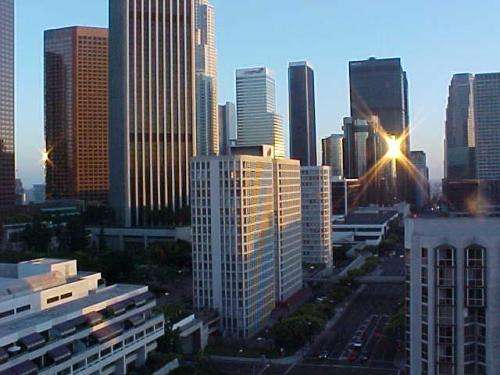Will smoggy L.A. have 'zero bad air' in 2025? Don't hold your breath

It was one of Mayor Eric Garcetti's most dramatic pledges in his sweeping "Green New Deal" for Los Angeles: "We will have zero days of unhealthy air quality by 2025."
The goal, it turns out, was not as ambitious as it sounded.
Rather than using current federal health standards, the mayor's plan relied on an outdated measure of whether the air in the nation's worst-polluted metropolis is safe to breathe.
After air quality experts criticized that benchmark as misleading, the mayor's office scrubbed all mention of zero unhealthful smog days from the 77-page document.
The plan now reads: "The City will reach the U.S. EPA 80 (parts per billion) ozone attainment standard by 2025 and meet all future compliance dates."
Today, air quality officials use the more stringent U.S. Environmental Agency limit of 70 parts per billion to determine whether air has safe levels of ozone, the lung-damaging gas in smog that triggers asthma and other respiratory illnesses.
The older, 80-ppb standard was adopted in 1997 by the Clinton administration, and has been strengthened twice since then.
Air quality experts contacted by The Times criticized the zero days unhealthful air claim when the plan was released April 29.
Reducing ozone pollution to 80 ppb is certainly more achievable, especially within Los Angeles, which already has lower smog levels and fewer bad air days than communities farther inland. But describing that as zero unhealthful days gave the unrealistic impression that L.A. smog could be eliminated within a few years. In fact, air pollution has been getting worse in recent years.
"Claiming that the air will be healthy when there are no days below 80 parts per billion is misleading," said Suzanne Paulson, a professor of atmospheric chemistry who directs the Center for Clean Air at UCLA.
On Thursday, the mayor's office said it had no intention to mislead, and changed the document only to clarify the metric it had been using all along: The deadline Southern California faces under the federal Clean Air Act to clean ozone pollution to 80 ppb by 2023.
"The Green New Deal is a living plan—and we should always be open to clarifying the work ahead," Lauren Faber O'Connor, the city's chief sustainability officer, wrote in an email. "Our air quality goals have always been aligned with the U.S. EPA ozone standards for Southern California."
The difference between 70 and 80 ppb is significant.
Last year, Los Angeles County experienced 90 days that violated the current 70-ppb standard, according to the South Coast Air Quality Management District. Using the older, 80-ppm standard, only 18 of those days would be considered unhealthful.
The "zero days of unhealthy air" goal was one of many aggressive targets in Garcetti's plan, which seeks to combat climate change by slashing emissions from buildings, cars and power plants and switching to electric vehicles and renewable energy.
The mayor's office said the replacement of the zero bad air days language—made a day after the plan's release—was the only substantive change.
The stubborn resurgence of Southern California smog has raised the stakes in the fight against air pollution. After decades of improvements, ozone levels are once again increasing amid hotter, smog-trapping weather and inadequate emissions reductions.
Given the dire circumstances of Southern California air quality, some experts and regulators said the mayor's plan was still a step toward cleaner air. Cleaning ozone levels to 80 ppb will still "yield important health benefits: healthier lungs in growing kids and less emergency room visits," a state Air Resources Board spokesman said.
"I don't see this as a major faux pas," said Anthony Wexler, director of the Air Quality Research Center at UC Davis.
"Even if you make the 80, you're going to save a lot of lives," he said.
©2019 Los Angeles Times
Distributed by Tribune Content Agency, LLC.




















